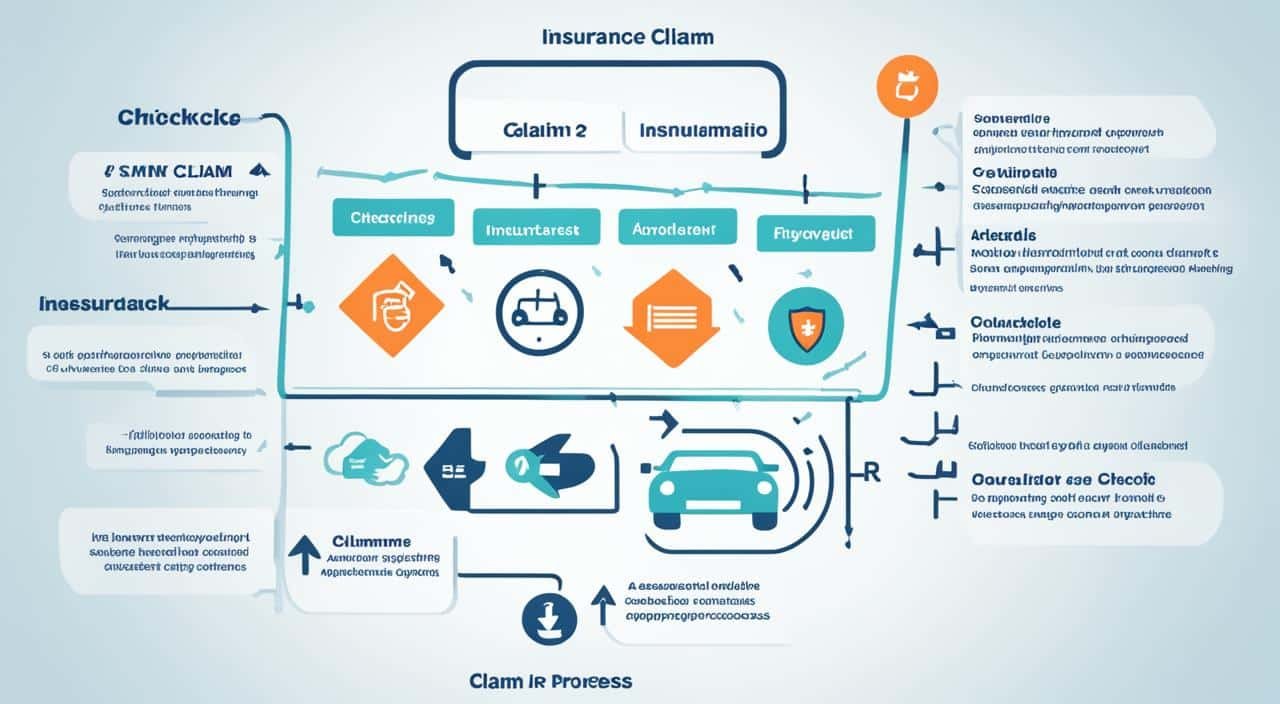After a disaster or unforeseen incident, policyholders must file an insurance claim to access their policy benefits. The insurance claim process has several steps. From reporting the loss to the insurance provider to getting the final claim payment. It’s important to understand these steps for a smooth claim.
The process starts when the policyholder tells their insurance company about the incident. They should do this as soon as possible. This step lets the insurer know that a covered loss has happened. The policyholder then needs to complete some forms, show evidence of the damage, and send the claim in.
The insurance company investigates the claim and checks the policy coverage. They look at the damage to figure out how much to pay. The payment may go to the policyholder, the mortgage lender, or the repair contractor. Good communication with the insurance company and following the right steps are key to a successful insurance claim.
Key Takeaways
- The insurance claim process involves several steps, from reporting the loss to receiving the final payment.
- Policyholders must notify their insurance company about the incident as soon as possible to initiate the claim.
- The insurance company will investigate the claim, review the policy coverage, and evaluate the damage before determining the payout amount.
- Claim payments may go directly to the policyholder, the mortgage lender, or the contractor hired for repairs.
- Clear communication and following the proper steps are crucial for a successful insurance claim.
Understanding the Insurance Claim Process
The insurance claim process is vital in the insurance world. It guides policyholders on steps to take for compensation. Knowing the insurance claim process is key to a hassle-free claim experience.
What is an Insurance Claim?
An insurance claim is when a policyholder asks their insurer for compensation. This comes after a covered loss or damage, like in car accidents or home disasters. Policyholders must file claims only for what their insurance policy covers.
How Does an Insurance Claim Work?
Filing a claim involves steps, from reporting the loss to getting the payment. This system ensures claims are fair and following policy rules. Knowing how it works helps policyholders get through the process easier.
Filing Your Insurance Claim
Filing an insurance claim depends on your policy. But, there are some steps to ensure success. If you’re claiming through auto, home, health, or life insurance, understanding the basics is key.Let’s talk about auto insurance claims first.
How to File an Auto Insurance Claim
First, tell your insurance provider about the accident or issue quickly. Share when, where, and who was there. Include evidence like photos and police reports. You’ll get a claims adjuster who decides what you get back.
How to File a Home Insurance Claim
If it’s a home insurance claim, start by reporting the loss to your provider. It could be from a disaster, theft, or another problem. Show the damage and give documents like receipts. An adjuster will visit to confirm and talk about what you’re owed.
How to File a Health Insurance Claim
Health insurance claims may differ by plan and service. You usually fill out a claim form and add bills or receipts. The insurer checks your claim and pays you or the doctor back.
How to File a Life Insurance Claim
With life insurance, the beneficiary usually tells the company of the policyholder’s death. You must show a death certificate and other needed documents. The insurer checks and then pays the beneficiary.
Always follow your insurer’s rules when making a claim. Do the paperwork, meet deadlines, and stay in touch. This helps you get through the process smoothly.
Insurance Claims Payments

The way you get money from an insurance claim can be different for each policy. Auto insurance claims, home insurance claims, and health insurance claims have their own steps. Knowing how each works can make dealing with insurance claims easier.
How Auto Insurance Claims Are Paid
If you have a claim for auto insurance, you might pick where your car gets fixed. The insurance company might pay the repair shop directly. Or, they might pay you back if you paid for the repairs first. They may even make the check out to you and the bank if you’re still paying for your car.
How Home Insurance Claims Are Paid
Home insurance claims are handled in a different way. The insurance company might give you a check to cover the damage. You then pay the repair people. Or, they might pay the repair people themselves if the damage is really bad. This avoids you handling the money directly.
How Health Insurance Claims Are Paid
Getting money for health insurance claims starts with you paying any fees you owe. Then, your insurance pays you back or pays the doctor directly. How much you get paid depends on your plan, the doctor’s agreement with your insurer, and the care you received.
Every insurance type has its own way of paying claims. Knowing the steps and how to handle the process can lead to a quick and easy resolution. This can help you get your claims settled without trouble.
Insurance Claim Process

The claim process usually has five main steps. It begins when the policyholder tells the insurance company about the loss. Then it moves to the final settlement of the claim. These stages are key to a smooth and efficient claims handling process.
- Reporting the Loss: The policyholder informs the insurance company about the incident.
- Claim Investigation: An adjuster from the insurance company checks the details of the claim.
- Reviewing the Policy: The insurance company looks at what’s covered in the policy to see if the claim applies.
- Evaluating the Damage: They assess the loss or damage, often bringing in experts to help.
- Claim Settlement and Payment: This is the last step, where the policyholder gets the money for repairs or replacements.
Knowing these steps helps policyholders manage claims better. It makes the insurance claim procedure smoother and more successful.
Reporting the Loss

The first thing you need to do is tell your insurance company about the loss. This reporting insurance claims step lets them know what’s happened. It shows them you need to make a claim because of an event that your policy covers.
Connect with Your Insurance Broker
Next, reach out to your insurance broker. Let them know about the incident and start the claims process. It’s important to give them clear details. Doing so makes sure the insurance company fully gets what your claim involves.
Provide Detailed Information
When you give details of your claim, be ready to talk about when and where it happened. Also, describe what was damaged or lost. You should also give them anything that supports your claim, like photos or receipts. This can initiating insurance claim process and make things move quicker.
Claim Investigation

After a loss is reported, the insurance company starts the insurance claim investigation. They do this by assigning a claims adjuster to look into the claim’s details.
Adjuster Evaluates the Claim
A claims adjuster works to understand the claim fully. They check the incident, review coverage, and inspect the site if needed. They also look at any documents and evaluate the damage or loss.
Gathering Evidence and Witness Accounts
The adjuster also collects more information after the initial report. This includes speaking with people involved, taking photos or videos, and getting repair estimates. Different pieces of evidence help build a clear view of what happened.
This investigation is key in deciding about the claim. It makes sure the right coverage is used and the correct payout is decided.
Reviewing Your Policy
After checking claims, the insurance company looks closely at the insurance policy. They do this to see what’s covered and what deductibles apply. It’s very important to figure out the policy limits and exclusions for the final payout.
Determining Coverage and Deductibles
The company carefully checks what you’re covered for and any limits. They also confirm which deductibles you’ll have to pay first. This is before the insurance’s help starts.
Understanding the insurance policy is key to knowing how much you can get. This is why they look at all details. They want to make sure you get what you deserve based on your insurance policy.
Evaluating the Damage

The insurance company will do a deep dive into the policyholder’s coverage. After that, they will start a thorough insurance claim damage evaluation. This evaluation checks the type and extent of the losses or damages. It’s key for figuring out the right payout.
Expert Appraisals and Assessments
A claims adjuster or a team from the insurance company will check out the damage. They look at how much it costs to fix and the overall impact of the loss. Sometimes, they bring in experts like contractors or engineers for more info.
Preferred Vendor Selection
The insurance company often has preferred vendors for repairs they trust. They can be a big help with making repairs go smoothly. Policyholders might have to use them to make sure repairs are done right and quickly.
| Key Factors in Evaluating Insurance Claim Damage | Benefits of Using Preferred Vendors for Repairs |
|---|---|
|
|
By carefully checking out the damage and using trusted vendors, the insurance company aims for a smooth process. It helps ensure an honest and quick review, making everyone happier.
Claim Settlement and Payment
The final step in an insurance claim is when the policyholder gets their money. This money is meant for finishing repairs or replacing items. There are important steps to follow for the payment to happen smoothly.
Finalizing Repairs and Replacements
After the insurance company approves the claim, the policyholder can start fixing things. They might have to use specific vendors chosen by the insurance. Or they could be buying new items with what the insurance gives them.
Receiving Your Claim Payment
Finally, the policyholder gets the money from their insurance claim. The payment goes to them, their mortgage lender, or the contractor, depending on the situation. With this money, all claim steps are done, and the process is over.
Also read: How Do You Choose The Right Health Insurance For Your Family?
Conclusion
The insurance claim process is detailed, but understanding key steps can make it easier. From first filing the claim to getting paid, it goes through important stages. These include investigating the claim, checking the policy, evaluating damages, and reaching a settlement.
By knowing about the claims process, navigating insurance claims, and tips for successful claims, it becomes smoother. It’s all about making the experience better for policyholders.
The insurance claim process overview and the key steps in claims management are important to understand. They help make the claim process work better for you. Keeping up with information, giving correct details, and working closely with the insurer are key steps.
As the world of insurance keeps changing, staying alert is crucial. Knowing the latest and working with experts in insurance can make things easier. This way, policyholders can make their way through claims confidently and get what they deserve.
FAQs
What is an insurance claim?
An insurance claim is a request you make to your insurance company. You ask them to pay you for a loss or damage. This could be after a car accident, a storm hurts your home, or in medical emergencies. It covers many events people can get help for.
How does the insurance claim process work?
The claim process has a few steps. First, you tell your insurance about the loss. Then, you fill out paperwork and show proof. The company checks your policy, looks at the claim, and decides how much to pay. Finally, they give you the money owed for the damage.
How do I file an auto insurance claim?
If your car is in an accident, tell your insurance company right away. You must give them the details and any paperwork they need. An adjuster will check the car’s damage with you. After that, they decide the payment.
How do I file a home insurance claim?
If something happens to your home, call your insurance provider. Tell them what happened and send photos. They will send someone to look at the damage. Then, they will tell you how much they’ll pay to fix it.
How do I file a health insurance claim?
To claim health insurance, send your medical bills and reports to your insurer. Also, tell them what medical services you got. They will look at your claim and pay you back according to your policy.
How do I file a life insurance claim?
In case of a life insurance claim, the beneficiary should contact the company. Give them a copy of the death certificate. The company checks the claim and pays out if everything is in order.
How are auto insurance claims paid?
Auto claims are paid either to you or straight to the repair shop. After your claim is approved, the insurance company sends a check for the repairs. You can then pay the repair shop with this money.
How are home insurance claims paid?
Home claims are usually paid to you. You can use the money for repairs. Or, sometimes the insurance sends the payment to the repair company instead.
How are health insurance claims paid?
For health claims, the insurance might pay the doctor directly. Or, they might pay you back. They check your bills and say how much they’ll pay, following your policy.
What are the key steps in the insurance claim process?
There are five steps in the claim process: 1) You tell the insurance about your loss, 2) They check your claim, 3) They look into your policy, 4) They see how much the damage costs, and 5) They pay you for the claim.
Source Links
- https://www.iii.org/article/understanding-the-insurance-claims-payment-process
- https://www.northbridgeinsurance.ca/blog/5-steps-insurance-claims-process/
- https://www.insurancebusinessmag.com/us/guides/insurance-claims-how-to-process-to-file-and-how-long-it-will-take-428385.aspx





